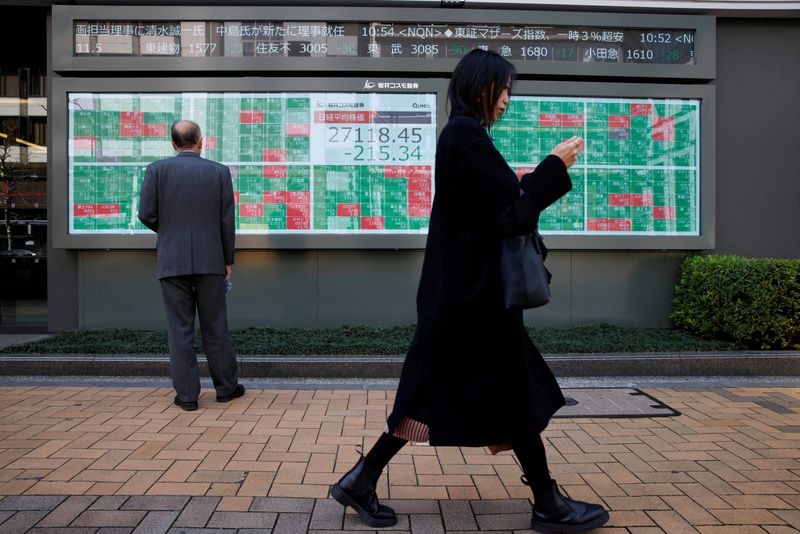Select Language

By Tom Westbrook
SINGAPORE (Reuters) - Stocks were headed for their biggest weekly rise in a year on Friday, while bonds rallied and the dollar was on the back foot as investors cheered a pause in U.S. interest rate hikes.
U.S. jobs data due later in the day is the next major focus.
Benchmark 10-year Treasury yields are down more than 20 basis points in two sessions since the U.S. Federal Reserve left rates on hold on Wednesday and Chair Jerome Powell said risks to the outlook for rates settings was balanced.
Cash Treasuries were untraded in Asia as markets were closed in Tokyo due to a holiday, and 10-year futures held recent gains to imply yields were steady at 4.67%. MSCI's broadest index of Asia-Pacific shares outside Japan rose 0.9%.
S&P 500 futures were 0.1% lower, weighed by a 3% fall for Apple shares (NASDAQ:AAPL) in post-market trade after the tech giant's sales forecast fell short of expectations.
World stocks are up 4.2% for the week so far, their largest weekly rise since November 2022.
"Markets have become increasingly confident that rates in the U.S. have now peaked," said ANZ analysts in a note.
"As logical as that is ... Powell did warn that for higher bond yields to forestall another hike, they'd need to stay high, so markets can't have their proverbial cake and eat it too."
The U.S. Treasury department had also said on Wednesday that it would sell less longer-dated debt at auction than had been expected and a softer-than-forecast manufacturing survey helped reinforce bets that no further hikes are necessary.
On Thursday, the Bank of England also left interest rates on hold and stressed it did not expect to cut them any time soon.
Ten-year gilts had their sharpest rally in more than a month, sending yields almost 12 basis points lower to 4.39%. Ten-year German bund yields also fell on Thursday, though only by 4.6 bps to 2.71%.
"It felt like there were a decent chunk of investors waiting on the sidelines and ready to play lower yields and yesterday removed a couple of potential stumbling blocks to enacting that view," said Rabobank analysts.
PAYROLLS LOOM
In foreign exchange markets the Australian dollar is leading gains among G10 currencies this week after a third-quarter inflation surprise had traders betting on a rate hike from the Reserve Bank of Australia (RBA) on Tuesday.
Australian retail sales stumbled in the September quarter, with sales-per-person posting the largest annual drop on record, data on Friday showed.
The Australian dollar is up 1.5% to $0.6430 and has broken above its 50-day moving average. The New Zealand dollar is not far behind with a 1.4% gain to $0.5892. [AUD/]
"Money markets are more than fully priced for another RBA hike by Q1, eye-catching in the G10. So the Aussie has a degree of support from RBA expectations that it has rarely had since the pandemic," said Westpac analyst Sean Callow.
"(But) a run at $0.65 is likely to require either a notably weak U.S. jobs report or a hawkish hike from the RBA."
Economists polled by Reuters expect the U.S. to have added 180,000 jobs in October.
The worst performing G10 currencies for the week have been the havens of Japanese yen and the Swiss franc as investors have sought out riskier assets.
The Bank of Japan will continue to dismantle its ultra-easy monetary policy next year, six sources familiar with the BOJ's thinking told Reuters, though the slow progress has been cold comfort for a yen weighed down by Japan's low interest rates.
It traded at 150.44 per dollar on Friday. Brent crude futures are 4% lower on the week to $86.80 a barrel. Gold is down 1% at $1,983 an ounce.
Bitcoin has surged 15% with the mood and looks to be reviving momentum that had collapsed along with exchange FTX in 2022. FTX founder Sam Bankman-Fried was found guilty of stealing from customers on Thursday. Bitcoin bought $34,600.

